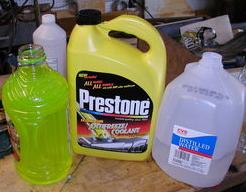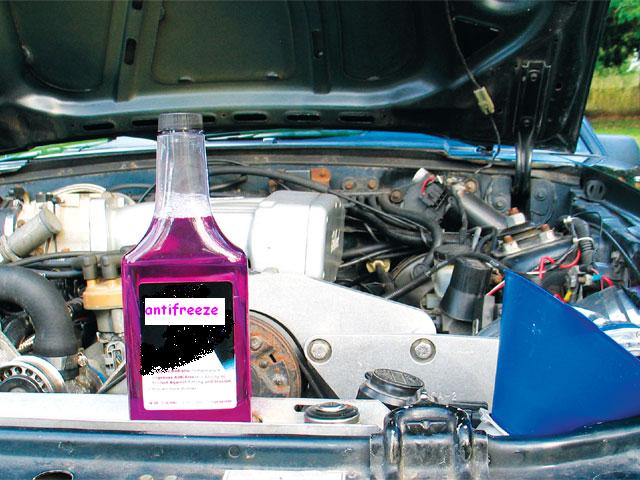Antifreeze: Bad for Your Kids and Pets

The Bottom Line
It is dangerous to swallow antifreeze, even small amounts. For several hours after swallowing, everything seems fine. But don't be fooled - the body is busy breaking down the antifreeze (ethylene glycol) into a number of substances that affect blood chemistry, the nervous system, and kidneys. If the victim survives, there may be permanent damage to the kidneys and brain.

The Full Story
We couldn't drive anywhere without it. But even small amounts are dangerous if your children, pets, or anyone else swallows it. Here's what you need to know.
Why would anyone swallow antifreeze? Children swallow ANYTHING they can reach, just because it's there. Pets lap it up because it's sweet. Adults have been poisoned because someone poured antifreeze into soft drink containers. Antifreeze naturally has a sweet taste, so even adults can be fooled.
How does antifreeze harm you? Antifreeze is tricky. For several hours after someone swallows it, everything seems fine. But the body is busy breaking down the antifreeze (ethylene glycol) into a number of substances that affect your blood chemistry, nervous system, and kidneys. After a few hours, someone poisoned by antifreeze may seem drunk or groggy and complain of stomach distress. After a few more hours, the victim may go into a coma. The kidneys can be damaged and stop making urine. If the victim survives, there may be permanent damage to the kidneys and brain.
How is antifreeze poisoning treated? The best time to treat is BEFORE symptoms develop! If you think someone has swallowed antifreeze, immediately use the webPOISONCONTROL® online tool or call Poison Control:1-800-222-1222. If hospital care is needed, treatment may include an IV antidote and kidney dialysis.
How do I prevent antifreeze poisoning? Children (and pets) won't swallow or touch anything that's out of sight and reach. Store antifreeze in its original container, locked where children can't see or reach it. Don't use antifreeze when children or pets are around. Re-close the cap tightly after use. Clean up any spills or leaks immediately. And never transfer antifreeze to another container, especially a food or drink container.
Is there a safer product? Some brands of antifreeze contain propylene glycol, which is less dangerous to swallow than ethylene glycol. If you decide to use this type of antifreeze, check your owners' manual to be sure you won't void your warranty. You would need to flush and drain your cooling system first. (But we're toxicologists, not mechanics! Talk to your own mechanic first!)
If antifreeze is dangerous to swallow, why does it taste so good? The natural taste of ethylene glycol is sweet. A lot of antifreeze brands contain a bitter substance, so that no one would drink more than one sip. While that sounds like a good idea, studies so far don't prove it to be effective.
I change my own antifreeze. What should I do with the old antifreeze? Antifreeze is a hazardous material that can contaminate ground and water. Fortunately, it can be recycled. How to dispose of used antifreeze depends on where you live. Some counties accept antifreeze at household hazardous waste collection stations; contact your county environmental services department or department of public works to learn your local options. Also, in some states, designated service stations are authorized to collect used antifreeze for recycling.
Rose Ann Gould Soloway, RN, BSN, MSEd, DABAT emerita
Clinical Toxicologist
Poisoned?
Call 1-800-222-1222 or
Prevention Tips
- Store antifreeze in its original container, locked where children can't see or reach it.
- Don't use antifreeze when children or pets are around.
- Re-close the cap tightly after use.
- Clean up any spills or leaks immediately.
- Never transfer antifreeze to another container, especially a food or drink container.
This Really Happened
Case 1: The parent of a 3-year-old girl put antifreeze in a water bottle. The product contains the toxic alcohol ethylene glycol (EG). The child then drank from the bottle but her parents didn't know how much she swallowed. They called Poison Control who advised them to take her to the nearest emergency room right away. Poison Control provided the emergency physician with treatment advice: obtain an ethylene glycol blood level and treat the child with fomepizole (an antidote that blocks the toxin produced by EG in the body). The child was in the hospital 24 hours of treatment.
Case 2: A small dog swallowed antifreeze at 7:00 PM one evening. His owner called Poison Control 12 hours later when the dog appeared inebriated. Poison Control told the owner that the antifreeze could be fatal and to go to the veterinarian immediately. By the time the veterinarian evaluated the dog, it was too severely poisoned to be treated and had to be euthanized.
For More Information
Tips about disposal and recycling of household waste, including antifreeze (EPA)References
Poisoned?
Call 1-800-222-1222 or
Prevention Tips
- Store antifreeze in its original container, locked where children can't see or reach it.
- Don't use antifreeze when children or pets are around.
- Re-close the cap tightly after use.
- Clean up any spills or leaks immediately.
- Never transfer antifreeze to another container, especially a food or drink container.
This Really Happened
Case 1: The parent of a 3-year-old girl put antifreeze in a water bottle. The product contains the toxic alcohol ethylene glycol (EG). The child then drank from the bottle but her parents didn't know how much she swallowed. They called Poison Control who advised them to take her to the nearest emergency room right away. Poison Control provided the emergency physician with treatment advice: obtain an ethylene glycol blood level and treat the child with fomepizole (an antidote that blocks the toxin produced by EG in the body). The child was in the hospital 24 hours of treatment.
Case 2: A small dog swallowed antifreeze at 7:00 PM one evening. His owner called Poison Control 12 hours later when the dog appeared inebriated. Poison Control told the owner that the antifreeze could be fatal and to go to the veterinarian immediately. By the time the veterinarian evaluated the dog, it was too severely poisoned to be treated and had to be euthanized.
